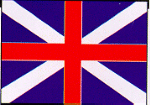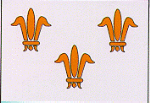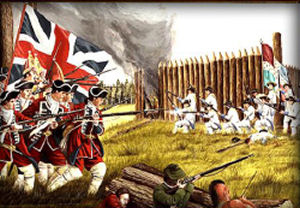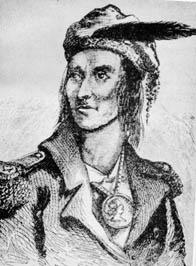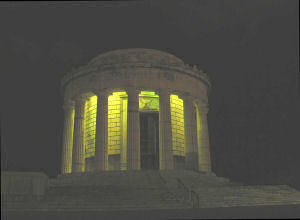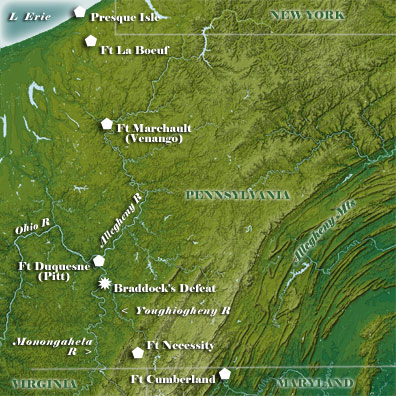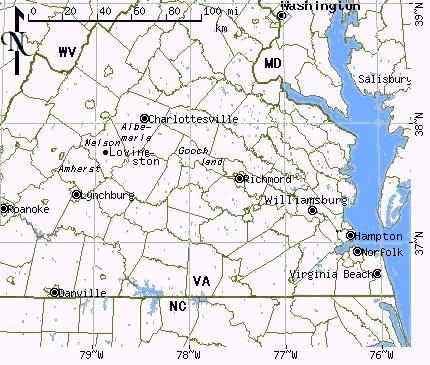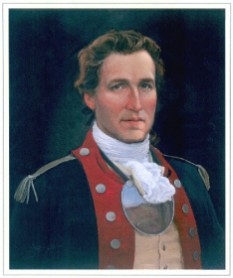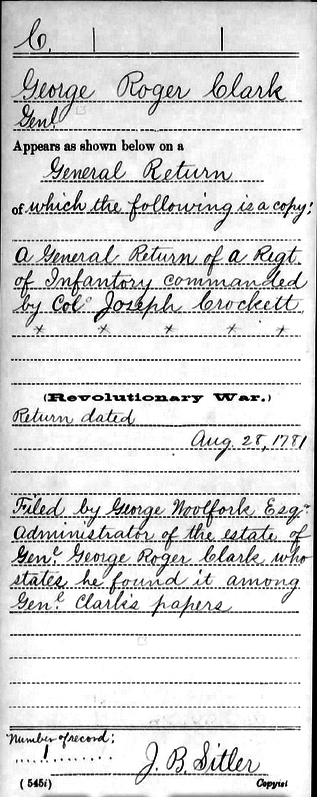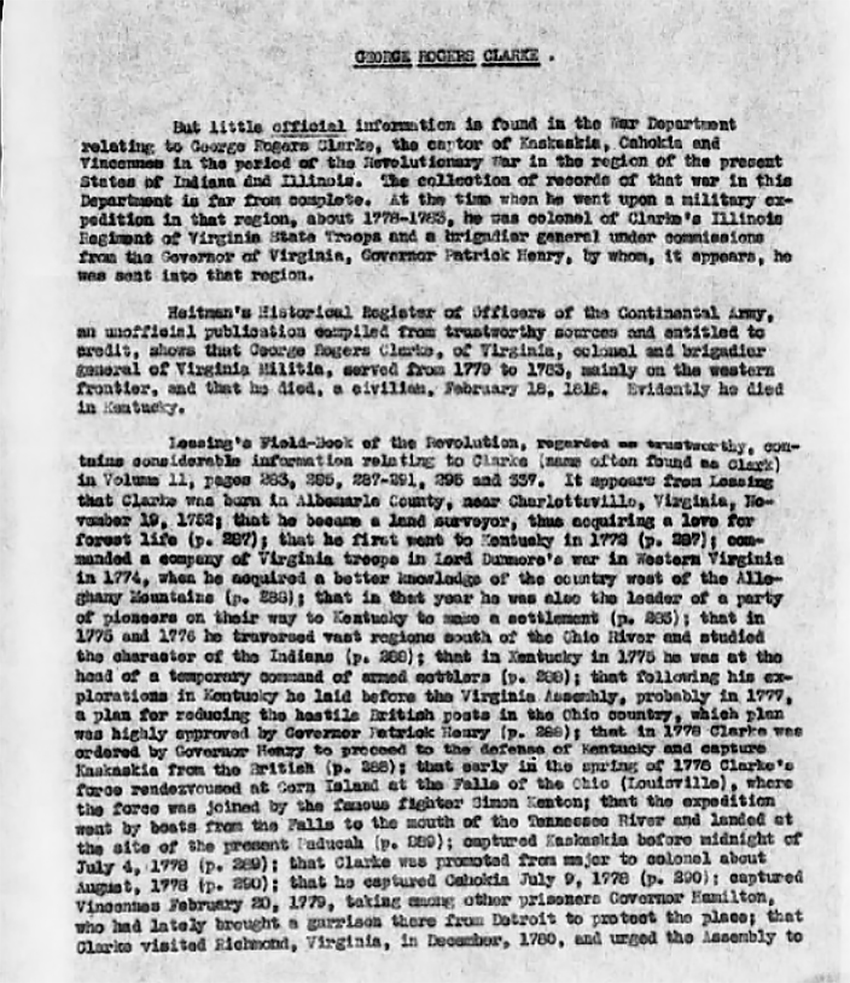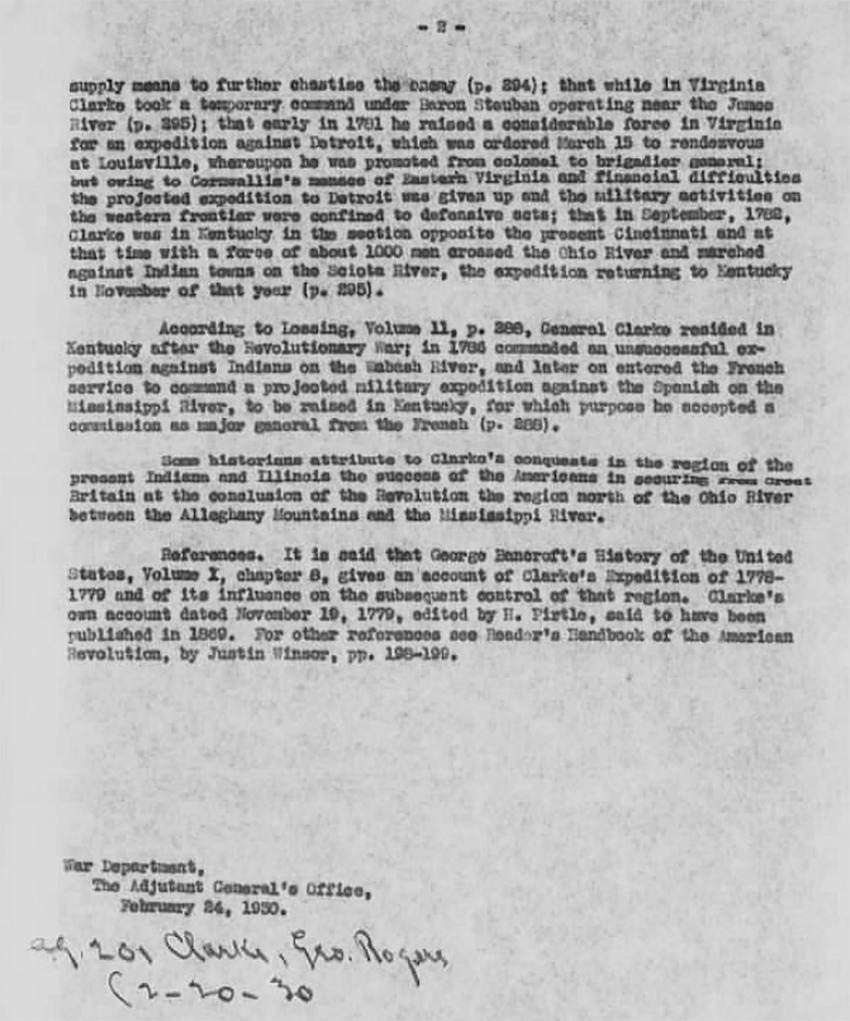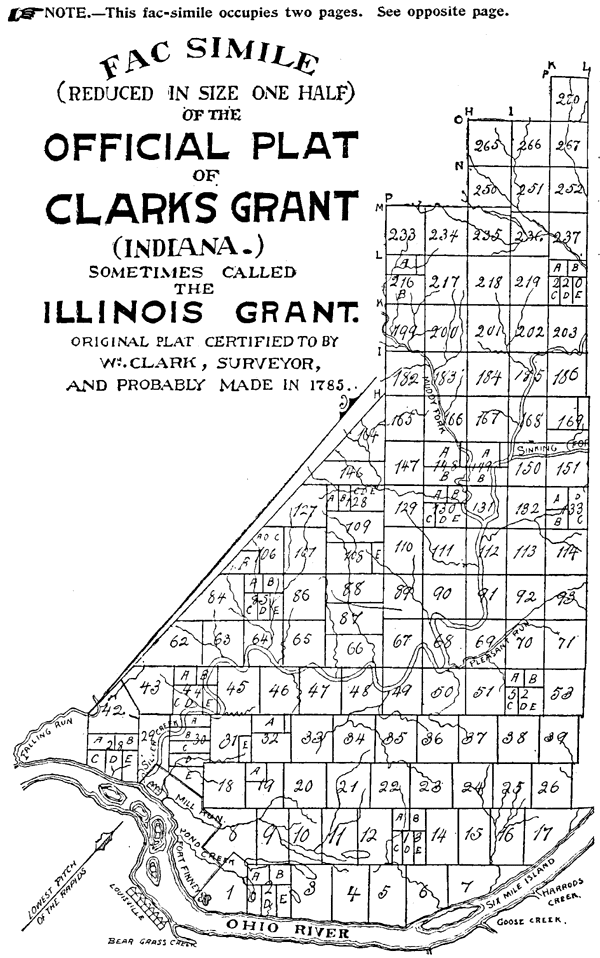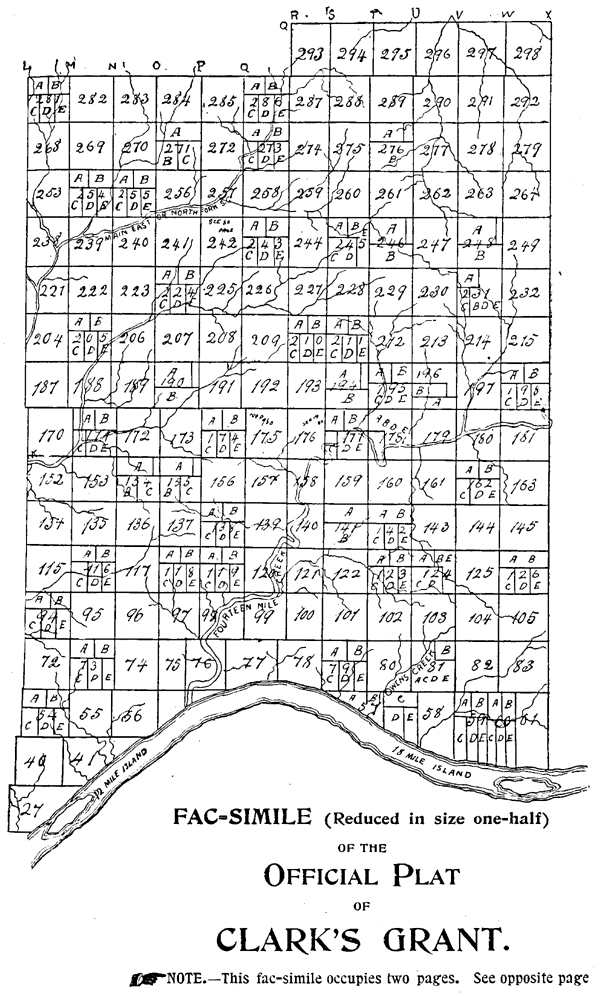It will be remembered that at the time the Illinois campaign was inaugurated, George Wythe, George Mason and Thomas Jefferson wrote a joint letter to George Rogers Clark, congratulating him upon his appointment to conduct so important an enterprise, and most heartily wishing him success. The letter then gave him this assurance:"We have no doubt that some further rewards in lands in the country will be given to the volunteers who shall engage in this service in addition to the usual pay, if they are so fortunate as to succeed. We think it just and reasonable that each volunteer, entering as a common soldier in this expedition, should be allowed three hundred acres of land and the officers the usual proportion, out of the lands which may be conquered in the country now in possession of the Indians, so as not to interfere with the claims of any friendly Indians, or any people willing to become subjects of this commonwealth; and for this we think you may safely confide in the justice and generosity of the Virginia assembly."
A fac-simile of this historic letter, dated January 3, 1778, has already been given in a previous chapter, and these gentlemen, no doubt, exercised all their influence to carry out the assurances then given.
On the 2d of January, 1781, the general assembly of Virginia adopted a resolution providing that, "as Colonel George Rogers Clark planned and executed the secret expedition by which the British posts were reduced, and was promised if the enterprise succeeded a liberal gratuity in lands in that country for the officers and soldiers who first marched thither with him, that a quantity of land not exceeding one hundred and fifty thousand acres be allowed and granted to the said officers and soldiers, and the other officers and soldiers that have been since incorporated into the said regiment, to be laid off in one tract, the length of which not to exceed double the breadth, in such place on the northwest side of the Ohio as the majority of the officers shall choose, and to be afterwards divided among the said officers and soldiers in due proportion according to the laws of Virginia."* (*Hening, 10, 565.)
In 1783 another act was passed by Virginia, "for locating and surveying the one hundred and fifty thousand acres of land granted by a resolution of assembly to Colonel George Rogers Clark, and the officers and soldiers who assisted in the reduction of the British posts in the Illinois: "Be it enacted by the General Assembly, That William Fleming, John Edwards, John Campbell, Walker Daniel, gentlemen, and George Rogers Clark, John Montgomery, Abraham Chaplin, John Bailey, Robert Todd, and William Clark, officers in the Illinois regiment, shall be and they are hereby constituted a board of commissioners, and that they, or the major part of them, shall settle and determine the claims to land under the said resolution. That the respective claimants shall give in their claims to the said commissioners on or before the first day of April, one thousand seven hundred and eighty-four; and, if approved and allowed, shall pay down to the said commissioners one dollar for every hundred acres of such claim, to enable them to survey and apportion the said lands. The said commissioners shall appoint a principal surveyor who shall have power to appoint his deputies, to be approved by the said commissioners, and to contract with him for his fees. That from and after the said first day of April, one thousand seven hundred and eighty-four, the said commissioners, or the major part of them, shall proceed with the surveyor to lay off the said one hundred and fifty thousand acres of land on the northwest side of the Ohio river, the length of which shall not exceed double the breadth; and, after laying out one thousand acres at the most convenient place therein for a town, shall proceed to lay out and survey the residue, and divide the same by fair and equal lot among the claimants; but no lot or survey shall exceed five hundred acres. That the said commissioners, in their apportionments of the said land, shall govern themselves by the allowances made by law to the officers and soldiers in the Continental army. That the said commissioners shall, as soon as may be, after the said one hundred and forty-nine thousand acres shall be surveyed, cause a plat thereof, certified on oath, to be returned to the register's office, and thereupon a patent shall issue to the said commissioners or the survivors of them, who shall hold the same in trust for the respective claimants; and they, or the major part of them, shall thereafter, upon application, execute good and sufficient deeds for conveying the several portions of land to the said officers and soldiers."* (*Blackford's Indiana Reports, Vol. 1, Appendix.)
The land was selected on the north side of the Ohio river, extending from below the falls, a little below Silver creek, up the river to the upper end of Eighteen Mile Island. It is situated in Clark, Floyd and Scott counties, Indiana, but mainly in the first named county. It was, in early times, generally called "Illinois Grant," but now, more frequently, "Clark's Grant, '' or simply, "The Grant." The location of the land was vested by the law "in a majority of the officers," but the tract selected was always a favorite locality with General Clark, and his choice was adopted by common consent.
William Clark was appointed principal surveyor of the grant, and he proceeded with a corps of four assistant surveyors, Edmund Rogers, David Steel, Peter Catlet and Burwell Jackson, to lay it off into tracts, intended, generally to contain five hundred acres each, but some of the surveys were very carelessly made. The errors, however, were almost invariably on the side of the soldier, as the tracts often over-ran in quantity, and but seldom if ever fell below it.
Historians have been bothered a good deal to identify this William Clark. Some have supposed he was the William Clark, brother of General George Rogers Clark, who afterwards became very prominent in connection with Merriweather Lewis, in making the first exploration to the Pacific, under the auspices of President Jefferson; others have supposed he was the William Clark who was one of the first United States judges of Indiana Territory. He was neither. He was the William Clark heretofore referred to as the son of Benjamin Clark, and was the brother of Marston Green Clark, and cousin of George Rogers Clark. He was decidedly a man of affairs and of fine ability. He probably had more to do in formulating the boundaries and allotting the lands in Clark's Grant than any other one person. The office plat was his work, and, besides being principal surveyor, he was one of the commissioners, and sometimes clerk of the board. He was, in fact, the general utility man of the concern, and acquired a considerable estate in lands. His will has never been published as far as the author has been able to learn, and is given here in full, as it throws considerable light upon the members of his branch of the Clark family. He died in November, or early in December, 1791.
The will of William Clark, the Surveyor.
"In the name of God, amen. I, William Clark, of Jefferson county, and District of Kentucky, late of Clarksville, being of perfect memory and knowing the uncertainty of this life, do make and declare this to be my last will and testament in the manner following. First desiring that my body be decently interred at the discretion of my executors hereafter named. And as for my temporal estate after all my just debts are paid, I give, bequeath and dispose of in the following manner:
"It is my will and desire that the bond payable to William Croghan may be discharged by a certificate now in my possession, the residue of said certificate to be applied as far as it will go to the discharge of a bond given to Richard Morris, and that the balance of said bond be discharged by my executors in the most speedy manner they may devise:
"It is my will and desire and I do hereby give my loving brother Marston Greene Clark a tract containing two hundred and fifty acres of land in Jefferson county and lying on Bear Grass, to him, the said Marston Green, his heirs and assigns.
"It is my will and desire, and I do hereby give to my loving brother Benjamin Wilson Clark and my loving sister Lucy Pool a tract containing nine hundred and thirty acres of land, to them and their heirs and assigns, lying in the lands given by the state of Virginia to the officers and soldiers of the Virginia state line, it being a part of my claim for military services performed the last war, to be equally divided in quantity and quality. And if my brother Benjamin Wilson and sister Lucy can not agree on a division my executors are to have a division made for them.
"It is my will and desire, and do hereby give to my loving brothers Jonathan and Everard Clark, to them, their heirs and assigns, a tract containing one thousand acres of land lying on Russell's creek including a noted burning spring, to be equally divided as above.
"It is my will and desire, and I do hereby give to my loving brother Benjamin Wilson Clark one tract containing four hundred acres in the Illinois Grant, it being part of number thirty-one, to him, his heirs and assigns.
"It is my will and desire, and I do hereby give to my loving brother Jonathan Clark, to him, his heirs and assigns, one tract containing five hundred acres in the Illinois Grant, number twenty-four. It is my will and desire, and I do hereby give to my loving brother Everard Clark, to him, his heirs and assigns a tract containing five hundred aces of land in the Illinois Grant, number ninety-six. It is my will and desire, and I do hereby give to my loving sister Lucy Pool, to her, her heirs and assigns, one tract containing five hundred acres of land in the Illinois Grant, number one hundred and sixty.
"It is my will and desire, and I do hereby give to my loving brother Marston Green Clark all my wearing apparel, a cow and calf, a sorrel mare, my desk, after my executors shall have finished the business of my estate; also my lots and houses in the town of Clarksville I lend him for the term of three years from the date of my decease, and if either of my brothers or sister comes to this country to live, within the space of three years after my decease, then he or she so coming shall have the lots and houses aforesaid, but if neither of them comes in that time then the lots, etc., are to remain the property of Marston Green Clark, to him, his heirs and assigns. Also I give to said Marston Green Clark one negro man, Lewis, for seven years, at the expiration of which time it is my wish said negro Lewis shall be liberated. It is my will and desire after my decease that my executors present my friend and relation Mrs. Elizabeth Anderson with my watch, as a memorial of my esteem and regard.
"It is my wish and desire that the remainder of my estate, viz: Five hundred acres of land in the Illinois Grant number two hundred and seventy-two, two hundred acres in said grant at the forks of Silver creek, the remainder of my military warrant, seven hundred and thirty-three and two-third acres, together with my gun, my surveyor's instruments, my gray horse, saddle and bridle, be disposed of at the discretion of my executors and the money arising from such sale to be applied to the payment of the bond payable to Richard Morris, and the overplus, if any, be equally divided amongst the above legatees, Marston Green Clark only excepted.
"Lastly, it is my will and desire, and I do hereby appoint my trusty friends, Richard Clough Anderson, William Croghan and Richard Terrell, executors of this, my last will and testament, hereby revoking all other wills. Signed this eleventh day of November, one thousand seven hundred and ninety-one."
This will was proven December 6, 1791, in Jefferson county, Kentucky, by the oaths of John Clark, George R. Clark and James O'Fallon, witnesses thereto, and ordered to be recorded.
The Virginia law vested in the same commissioners one thousand acres of land to be platted into half acre lots, with convenient streets, for a town, to be called Clarksville. This was laid off just above where Silver creek empties into the Ohio at the falls, as will hereafter be more particularly shown, with other proceedings in relation to said town. After deducting the town site, one hundred and forty-nine thousand acres remained to be divided between "the officers and soldiers who assisted in the reduction of the British posts in the Illinois," and, after it was surveyed, a patent was issued for the land, December 14, 1786, a fac-simile of which, reduced one-half in size is given in this chapter. The original of this important document is on parchment, with holes eaten in it by mice, or insects, as shown in the fac-simile.
The board met at Louisville, in 1784, for the purpose of allotting the land, and on the 3d of August of that year came to the following important conclusions as to the class of officers and soldiers entitled to share in the same, namely: "That all officers and soldiers who marched and continued in service till the reduction of the British posts on the northwest side of the Ohio, that all who engaged and enlisted in the Illinois regiment afterwards, and served during the war, or three years, are entitled to a share of the grant under the resolution and act of assembly, and that those soldiers who have enlisted in said regiment since the 2d day of January, 1781, for three years, or during the war, are not entitled, as there seems to be no provisions made under the resolution for those who should thereafter be incorporated in the said regiment; that the officers of the regiment are entitled to a share of the land in proportion to the commissions they respectively held on the said 2d day of January, 1781, and not in proportion to the commissions they have since held in consequence of promotions, and that therefore officers commissioned since that period are not entitled at all; and that those soldiers who enlisted to serve twelve months after their arrival at Kaskaskia, agreeable to an act of assembly of the fall session of 1778, for the protection and defense of the Illinois county, who did not re-enlist in the regiment, are not included in said resolution; that those officers who were commissioned under said act and resigned before the expiration of the twelve months are not entitled; last that those who continued during the year and then retired, not having a command, are entitled."
At a meeting of the commissioners, October 10, 1787, the scope of the order was enlarged so as to include "the officers and soldiers who were left at the falls by order of Colonel Clark, when the detachment were going against the Illinois, be allowed quota of land in the grant."
In view of the way the troops were raised, the irregularity of the terms of service, and there being different campaigns, with not the same soldiers in each, it was a difficult and delicate matter to determine, exactly, who "assisted in the reduction of the British posts in the Illinois," or what officers and soldiers were entitled to the share in the land under the law.
The commissioners, however, after long and careful investigation decided who were entitled, and the quantity of land that should be allotted to each; but, in the meantime, many of the land claims had been sold and transferred by the persons designated, and deeds for the land, in such cases, did not issue in their names, but in the names of the persons then owning the claims.
In consequence of this, and the mixing in of the names of persons who only served under Clark in his subsequent campaigns against the Indians, a correct list of the officers and soldiers of the Illinois Regiment who "assisted in the reduction of the British posts," and were allotted land under the law, has never before been published. At least the author, after the most diligent search, has never been able to find any such list, although he has found several which were clearly misleading and erroneous.
The following roll was made with great care and labor, tracing the title of every tract of land back to the person who served for it. It is confidently believed that it is correct, and that it is the only full and complete list of those who were allotted land in the Illinois Grant, for service under General Clark, ever published. It is quite certain no one is on the list who did not serve, and it is not likely that many, if any, entitled to land, failed to receive it, either in person or by his heirs or assigns. While omissions are possible, they are not at all probable. The board of commissioners were prominent and honorable men, and it was continued in existence, by subsequent legislation, for at least sixty-five years, so that all having proper claims had abundance of time in which to apply.
It will be seen by reference to the roll that opposite the name of each person is given the quantity of land allotted to him, with its descriptive numbers, so that the reader, by referring to the fac-simile of the original plat, which immediately follows the list, can see the exact location of the land; or, by giving the number of any tract, it can, in like manner, be learned who served for it. For example, if it is desired to learn what land was allotted to the celebrated Simon Kenton, a reference to the list and map will show that it was "letter E, tract 198." Or if the reader wishes to know who served for number one, the tract on which the city of Jeffersonville is situated a similar reference will show it was Lieutenant Isaac Bowman. And so on as to any track or person.
It will be impossible for the general reader to comprehend the great labor involved in making this list. It was equivalent to making three hundred partial abstracts of title, aggravated by the fact that the certificate of claim was often assigned before the issuance of the patent, and that the patent frequently issued in the name of the assignee, and not of the soldier. The work is entirely original, and it is hoped its value will compensate for the labor required in its preparation.
While Colonel Patrick Henry of the 1st Virginia Regiment was technically the commander-in-chief of Virginia's forces, correspondence between the President of Virginia's Committee of Safety Edmund Pendleton and Colonel Woodford indicates that this was a political decision in recognition of Henry's efforts prior to the outbreak of hositilies. While Henry was a politician, Woodford had served in the French and Indian War and had real military experience. For this reason, the Pendleton decided to keep Henry in Williamsburg, Virginia while dispatching the 2d Virginia Regiment to meet Governor Dunmore's small "army" composed of detachments of the 14th Regiment of Foot, Marines, runaway slaves who had been formed into the Ethiopian Regiment.
The 2d Virginia Regiment, along with elements of the Culpeper Minute Battalion, engaged the British at the battle of Great Bridge (modern day Chesapeake Virginia), which was a decisive victory. Colonel William Woodford, reporting on the 2d Virginia Regiment's Service at the Battle of Great Bridge, wrote in a letter published in Purdie's Virginia Gazette December 15, 1775: "This was a second Bunker's Hill affair, in miniature; with this difference, that we kept our post, and had only one man wounded in the hand."
Minor fighting would continue in Hampton and Norfolk, including the burning of Norfolk, which at the time was not only Virginia's largest city, but also a Loyalist stronghold. Originally raised for one year's state service, the 2d Virginia was accepted by Congress for Continental service on February 13, 1776, and reorganized at Suffolk as part of the Continental Army.
Dunmore would remove his force to Gywnn's Island, a small island where the Rappahannock River meets the Chesapeake Bay, where they would stay for several months along with a small flotilla of Royal Navy and loyalist ships. By July 1776, Virginia had expanded its forces to include several more infantry regiments and an artillery regiment under the command of General Andrew Lewis. The Virginia forces, including the 2d Virginia Regiment, would bombard Dunmore's position from a shore battery before launching an amphibious assault on the island. By the time the Virginians made it ashore, Dunmore's force withdrew to its ships and sailed away. They would raid Stafford County in late July 1776 before sailing for New York City.
Philadelphia campaign, 1777–1778
In December 1776, the 2d Virginia Regiment was ordered to join Washington's Main Army in New Jersey. Colonel Woodford was promoted to brigadier general and Alexander Spotswood became colonel of the 2d Virginia Regiment on February 21, 1777. The regiment marched to Baltimore, Maryland where it was equipped and then dispatched to Maryland's Eastern Shore to suppress local Loyalists, before making their way to Philadelphia for clothing, and finally joined the Main Army as part of Weedon's Brigade in Greene's Division.
In August 1777, Washington marched his army to counter the British landing at Head of Elk, Maryland with the objective of Philadelphia. A detachment of the 2d Virginia Regiment fought as part of Maxwell's Light Corps, a provisional formation made up of drafts of 100 men from each brigade, under Lt. Colonel Richard Parker at the battle of Cooch's Bridge on September 3, 1777. Greene's Division of Virginians had held off the British advance at the closing of the Battle of Brandywine, allowing the rest of the army to withdraw in good order. They were in the thick of confusion at the Battle of Germantown, so thick in fact that the 9th Virginia Regiment of Mulenburgh's Brigade fought with such success that it found itself cut off and captured to a man. Stephen's Brigade was engaged in an embarrassing example of "friendly fire" with Wayne's Brigade as they too had to retreat after pressing so much further than the Pennsylvanians mistook them for the British in the fog of battle because of the direction they were coming from. The 2d Virginia Regiment again served with distinction, as reflected in the Virginia Gazette, October 17, 1777: "The heroism and gallantry of the second Virginia regiment I cannot help particularly mentioning; they would do honour to any country in the world. It is universally believed they behaved the best of any troops in the field." Colonel Spotswood resigned after the Battle of Germantown to return to Virginia to take care of the family as he mistakenly thought his brother had been killed (he had in fact been wounded and captured). He was replaced by Colonel Christian Febiger, a Danish-born officer, who would command the regiment the rest of its existence. The 2d Virginia Regiment entered winter quarters at Valley Forge, emerging in June 1778 to fight at the Battle of Monmouth on June 28, 1778.
The Philadelphia Campaign had left the Virginia Line in shambles, depleting both men and supplies. On September 14, 1778, the 2d Virginia Regiment is officially consolidated with the 6th Virginia Regiment to make a "new" 2d Virginia Regiment. Colonel Febiger retains his command and Lt. Colonel Simms of the 6th Virginia Regiment becomes his new second in command. Even with this new consolidation, the regiments were understrength, and from this point forward would never operate as a "regiment" again. While encamped around New York City in both the Hudson Highlands and Northern New Jersey, officers deemed supernumerary were given new assignments (while officially holding their prior titles) and parties of men would be assigned duties under various captains. A return written by Inspector General Steuben indicates that the regiment only had 180 rank and file, which could form two divisions. It was decided that it would brigade with the 5th and 11th Virginia Regiments to "compose a Battalion" and that these there regiments would "furnish 61 Men for the Light Infantry". This light infantry "company" would be attached to Wayne's Corps of Light Infantry and took part in the storming of Stony Point in July 1779. Colonel Febiger would be one of these "supernumerary" officers and was assigned to command one of the composite battalions of light infantry in this attack. A month later, Captain Catlett and 50 men of the regiment would be under "Light Horse Harry" Lee at Paulus Hook (present day Jersey City) and was credited with covering the retreat from capturing this post.
At this point, regimental history becomes very confusing to track. Given the number of men fit for duty, these "regiments" are not really "regiments" at all any more, yet they are still named as such. In 1780, the word "Detachment" comes into use, describing a 700-man conglomeration of these "regiments" – larger than a regiment or battalion, smaller than a division. Colonel Febiger is sent to Philadelphia to arrange supplies for the Southern Army and then onto Virginia for recruiting. Three detachments are made out of recruits in Virginia and the remaining Virginia Continentals outside of New York City. The 2d Virginia Detachment is formed out of various regiments under the 2d Virginia Regiment's original colonel, Brigadier General William Woodford, including elements of the 2d Virginia Regiment and Lt. Colonel Gustavus Brown Wallace, Major Charles Pelham, Captains Alexander Parker and Benjamin Taliaferro can be placed with this detachment. The 3rd Virginia Detachment would be formed under Colonel Abraham Buford and was composed of elements of the 7th Virginia, as well as various pieces of other units, including two companies of the 2nd, Capt. Alexander Parker's and Capt. Thomas Catlett's. It is known that Captains Francis Cowherd and John Stokes were also with this detachment.
Notes:
This is important, and ties Wm Lynn to the Dunmore's War
1774, then serving in the 2nd VA Regt (1775), later
to join the continental army of George Washington (1776).
From this information, we can deduce that Lt/Capt Wm
Lynn of the 2nd VA, served under Gov Dunmore 1774. Then
fighting against Dunmore (1775), a British (Loyalist)
supporter, and then the 2nd was excepted into the
Continental Army February 13, 1776, and remained in the 2nd,
until he volunteered for Col George Rogers Clark's special
militia (1778), to fight the British and their Indian
supporters in the West, now Kentucky, which was part of
Virginia, at this time period.
I believe, that
some of the soldiers in this militia unit, who fought, in
Dunmore's War, in 1774, staid
on, and joined or formed, like Wm Lynn, into the 2nd VA,
which formed in 1775, and by an act of
Congress was excepted into the Continental Army in 1776.
